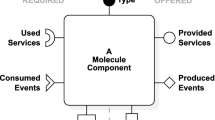Abstract
This paper characterizes various categories of reuse technologies in terms of their underlying architectures, the kinds of problems that they handle well, and the kinds of problems that they do not handle well. In the end, it describes their operational envelopes and niches. The emphasis is on generative reuse technologies.
Access this chapter
Tax calculation will be finalised at checkout
Purchases are for personal use only
Preview
Unable to display preview. Download preview PDF.
Similar content being viewed by others
References
Batory, Don, Singhal, Vivek, Sirkin, Marty, and Thomas, Jeff, "Scalable Software Libraries," Symposium on the Foundations of Software Engineering. Los Angeles, CA, December, 1993.
Batory, Don, and Martin, Jean-Philippe, “An Algebraic Foundation for Program Automation,” Personal Communication, 2001.
Biggerstaff, Ted J., "A Perspective of Generative Reuse," Annals of Software Engineering, 5, 1998, pp. 169–226.
Biggerstaff, Ted J., “Fixing Some Transformation Problems,” Automated Software Engineering Conference, Cocoa Beach, Florida (1999).
Biggerstaff, Ted J., "A New Control Structure for Transformation-Based Generators," In Software Reuse: Advances in Software Reusability, Vienna, Austria (Springer Lecture Notes in Computer Science, June, 2000).
Czarnecki, Krzysztof and Eisenecker, Ulrich, Generative Programming, Addison-Wesley, 2000.
Kiczales, Gregor, Lamping, John, Mendhekar, Anurag, Maede, Chris, Lopes, Cristina, Loingtier, Jean-Marc and Irwin, John: Aspect Oriented Programming. Tech. Report SPL97-08 P9710042, Xerox PARC (1997)
Neighbors, James M., "Draco: A Method for Engineering Reusable Software Systems." In Ted J. Biggerstaff and Alan Perlis (Eds.), Software Reusability, Addison-Wesley/ACM Press, 1989, pp. 295–319. (See also http://www.bayfronttechnologies.com/ for more information on DRACO and CAPE.)
Smith, Douglas R., "KIDS-A Knowledge-Based Software Development System," in Automating Software Design, M. Lowry & R. McCartney, Eds., AAAI/MIT Press, 1991, pp.483–514.
VanHilst, M. and D. Notkin, “Using C++ Templates to Implement Role-Based Designs”, JSSST International Symposium on Object Technologies and Systems (ISOTAS'96), 1996.
Editor information
Editors and Affiliations
Rights and permissions
Copyright information
© 2001 Springer-Verlag Berlin Heidelberg
About this paper
Cite this paper
Biggerstaff, T.J. (2001). A Characterization of Generator and Component Reuse Technologies. In: Bosch, J. (eds) Generative and Component-Based Software Engineering. GCSE 2001. Lecture Notes in Computer Science, vol 2186. Springer, Berlin, Heidelberg. https://doi.org/10.1007/3-540-44800-4_1
Download citation
DOI: https://doi.org/10.1007/3-540-44800-4_1
Published:
Publisher Name: Springer, Berlin, Heidelberg
Print ISBN: 978-3-540-42546-5
Online ISBN: 978-3-540-44800-6
eBook Packages: Springer Book Archive




